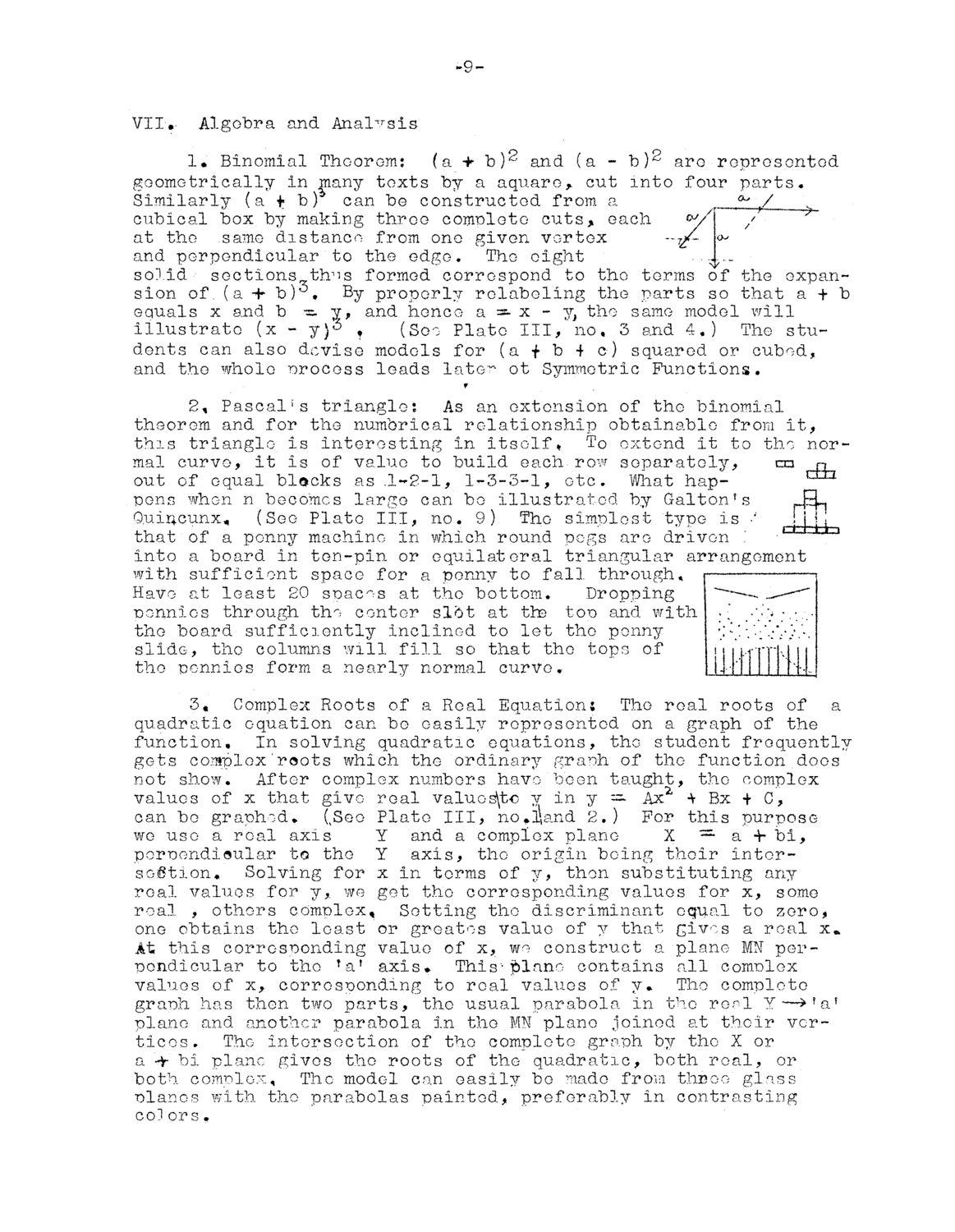| |
| |
Caption: Mathematical Models Construction and Use of Mathematical Models (Fehr & Hildebrandt)
This is a reduced-resolution page image for fast online browsing.

EXTRACTED TEXT FROM PAGE:
-9- VII,- Algebra and Analysis !• Binomial Theorem: (a + b)2 and (a - b)2 are represented geometrically in many texts by a aquaro* cut into four parts* Similarly (a > b ) can be constructed from a ^ L ->(V, cubical box by making three complete cuts* each at the same distance from one given, vertex and perpendicular to the edge. The eight solid-' sections thus formed correspond to tho terms of the expansion of. (a + b) • By properly relabeling the parts so that a + b equals x and b t& y, and hence a =- x - y, the same model will * illustrate (x - y)s t (Soo Plate III, n o , 3 and 4.) The students can also devise models for (a + b + c) squared or cubed, and the whole process leads later* ot Symmetric Functions, 2* Pascal*' s triangle; As an extension of the binomial theorem and for the numbrical relationship obtainable from it, this triangle is interesting in itself. To extend it to the normal curve, it is of value to build each row separately, out of equal blocks as .1-2-1, 1-3-3-1, etc. What happens when n becomes large can. be illustrated by Galton?s rfh Qulueunx« (See Plate III, no. 9). The simplest type Is • ' n± that of a penny machine in which round pegs are driven . ' Into a board In ten-pin or equilateral triangular arrangement with sufficient space for a penny to fall through,, Have at least 20 spaces at the bottom. Dropping pennies through the center slot at tie top and with the board sufficiently Inclined to let the penny slide, tho columns will fill so that the tops of ij-tiimi the pennies form a nearly normal curve. 3« Complex Roots of a Real Equation; The real roots of a quadratic equation can be easily represented on a graph of the function. In solving quadratic equations, the student frequently gets complex'roots which the ordinary graph of the function does not show. After complex numbers have been taught, the complex values of x that give real values\to y in y ^ Axz ' Bx + C, + can be graphed* (|Seo Plate III, no*l\and 2.) For this purpose we use a real axis Y and a complex plane X x a +bi, perpendicular to the Y axis, the origin being their intersection*. Solving for x In terms of y, then substituting any real values for y, we get the corresponding values for x, some real , others complex. Setting tho discriminant equal to zero, one obtains tho least or greatos value of y that gives a real x* At this corresponding value of x, we construct a plane MN perpendicular to the Ta? axis* This-plane contains all complex values of x, corresponding to real values of y* The complete graph has then two parts, tho usual parabola in the ronl Y — » ? a * plane and another parabola in the MN plane joined at their vertices* The intersection of the complete graph by the X or a -- bi plane gives the roots of the quadratic, both real, or y both complex. The model can easily bo made from three glass planes with the parabolas painted, preferably in contrasting col ors.
| |